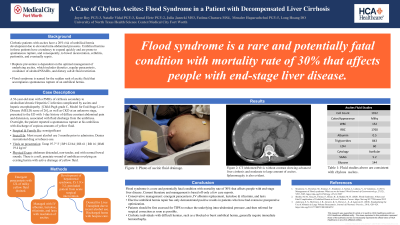Back


Poster Session C - Monday Afternoon
Category: Liver
C0565 - A Case of Chylous Ascites From Flood Syndrome
Monday, October 24, 2022
3:00 PM – 5:00 PM ET
Location: Crown Ballroom

Has Audio

Joyce Roy, DO
Medical City Fort Worth
Fort Worth, TX
Presenting Author(s)
Joyce Roy, DO1, Natalie Vidal, MD1, Kunal Elete, DO1, Julia Janecki, MSPH2, Fatima Charara, MS, DO3, Menalee Hapuarachchi, MD1, Long Hoang, DO4
1Medical City Fort Worth, Fort Worth, TX; 2University of North Texas Health Science Center, Fort Worth, TX; 3Henry Ford Macomb Hospital, Clinton Township, MI; 4UNT Health Science Center, Fort Worth, TX
Introduction: Cirrhotic patients with ascites have a 20% risk of umbilical hernia development during the course of their disease due to elevated intra-abdominal pressures. In rare cases, patients with large volume ascites may develop a spontaneous umbilical hernia rupture leading to a sudden rush of ascitic fluid through a skin lesion, a complication known as Flood syndrome. The development of Flood syndrome is often provoked by local trauma or sudden rise in intra-abdominal pressure such as coughing, straining, vomiting, heavy lifting, or large volume ascites. Complications of a ruptured umbilical hernia include bowel incarceration, cellulitis, peritonitis, evisceration of the small bowel, and eventually sepsis. In this case report, we present the unique case of a patient with decompensated liver cirrhosis complicated by Flood syndrome.
Case Description/Methods: We present the case of a 56 year old male with a past medical history of decompensated cirrhosis secondary to alcoholism/chronic Hepatitis C infection complicated by ascites and hepatic encephalopathy, and chronic kidney disease of unknown stage, who presented to the ED with spontaneous leakage of fluid from his umbilical hernia. Emergent paracentesis expelled a total of 12 L milky fluid in a stream from his umbilicus and the patient was medically managed with IV albumin. Peritoneal fluid analysis revealed glucose of 144, WBC of 152, fluid protein of 1.4, and elevated triglycerides of 843, suggesting chylous ascites. A fluid serum ascites albumin gradient (SAAG) of 3 and fluid protein of 1.4 suggested the etiology was primarily cirrhosis complicated by portal hypertension. Following paracentesis, his ascites did not recur. His kidney function declined and he developed hepatorenal syndrome, deeming him a poor candidate for surgical intervention of his umbilical hernia.
Discussion: Flood syndrome is a rare complication of refractory ascites and liver cirrhosis, with a significant morbidity and mortality rate of 30%. Rupture prevention is dependent on the optimal management of underlying ascites with conventional strategies that includes diuretics, regular paracentesis, avoidance of alcohol/non-steroidal inflammatory drugs along with dietary salt and fluid restriction. Due to the complexity of syndrome, surgical treatment is not a well-established procedure and is associated with a mortality rate of up to 30%, especially in patients undergoing emergent hernia repair.

Disclosures:
Joyce Roy, DO1, Natalie Vidal, MD1, Kunal Elete, DO1, Julia Janecki, MSPH2, Fatima Charara, MS, DO3, Menalee Hapuarachchi, MD1, Long Hoang, DO4. C0565 - A Case of Chylous Ascites From Flood Syndrome, ACG 2022 Annual Scientific Meeting Abstracts. Charlotte, NC: American College of Gastroenterology.
1Medical City Fort Worth, Fort Worth, TX; 2University of North Texas Health Science Center, Fort Worth, TX; 3Henry Ford Macomb Hospital, Clinton Township, MI; 4UNT Health Science Center, Fort Worth, TX
Introduction: Cirrhotic patients with ascites have a 20% risk of umbilical hernia development during the course of their disease due to elevated intra-abdominal pressures. In rare cases, patients with large volume ascites may develop a spontaneous umbilical hernia rupture leading to a sudden rush of ascitic fluid through a skin lesion, a complication known as Flood syndrome. The development of Flood syndrome is often provoked by local trauma or sudden rise in intra-abdominal pressure such as coughing, straining, vomiting, heavy lifting, or large volume ascites. Complications of a ruptured umbilical hernia include bowel incarceration, cellulitis, peritonitis, evisceration of the small bowel, and eventually sepsis. In this case report, we present the unique case of a patient with decompensated liver cirrhosis complicated by Flood syndrome.
Case Description/Methods: We present the case of a 56 year old male with a past medical history of decompensated cirrhosis secondary to alcoholism/chronic Hepatitis C infection complicated by ascites and hepatic encephalopathy, and chronic kidney disease of unknown stage, who presented to the ED with spontaneous leakage of fluid from his umbilical hernia. Emergent paracentesis expelled a total of 12 L milky fluid in a stream from his umbilicus and the patient was medically managed with IV albumin. Peritoneal fluid analysis revealed glucose of 144, WBC of 152, fluid protein of 1.4, and elevated triglycerides of 843, suggesting chylous ascites. A fluid serum ascites albumin gradient (SAAG) of 3 and fluid protein of 1.4 suggested the etiology was primarily cirrhosis complicated by portal hypertension. Following paracentesis, his ascites did not recur. His kidney function declined and he developed hepatorenal syndrome, deeming him a poor candidate for surgical intervention of his umbilical hernia.
Discussion: Flood syndrome is a rare complication of refractory ascites and liver cirrhosis, with a significant morbidity and mortality rate of 30%. Rupture prevention is dependent on the optimal management of underlying ascites with conventional strategies that includes diuretics, regular paracentesis, avoidance of alcohol/non-steroidal inflammatory drugs along with dietary salt and fluid restriction. Due to the complexity of syndrome, surgical treatment is not a well-established procedure and is associated with a mortality rate of up to 30%, especially in patients undergoing emergent hernia repair.

Figure: Chylous Ascities
Disclosures:
Joyce Roy indicated no relevant financial relationships.
Natalie Vidal indicated no relevant financial relationships.
Kunal Elete indicated no relevant financial relationships.
Julia Janecki indicated no relevant financial relationships.
Fatima Charara indicated no relevant financial relationships.
Menalee Hapuarachchi indicated no relevant financial relationships.
Long Hoang indicated no relevant financial relationships.
Joyce Roy, DO1, Natalie Vidal, MD1, Kunal Elete, DO1, Julia Janecki, MSPH2, Fatima Charara, MS, DO3, Menalee Hapuarachchi, MD1, Long Hoang, DO4. C0565 - A Case of Chylous Ascites From Flood Syndrome, ACG 2022 Annual Scientific Meeting Abstracts. Charlotte, NC: American College of Gastroenterology.
